MELeaf: A Newsletter From the Horticulture Program, May 26, 2021
In this issue:
Recently, a group of seven gooseberry plants were found for sale at a garden center in Maine. Maine’s white pine blister rust (WPBR) quarantine prohibits the sale, possession or planting of all Ribes species including gooseberries. WPBR is a disease of white pine that kills young trees, interferes with forest regeneration and attacks mature trees, reducing the value of the wood. Like many other rusts WPBR needs an alternate host to complete its lifecycle and Ribes species fill this role.
In this recent case, and in most instances when we find Ribes for sale, the business owner was unaware of the WPBR quarantine. Unfortunately, whether you are aware of the rules or not, the result is the same, the plants cannot be sold and are destroyed.
This incident also highlighted the importance of educational outreach on Maine’s rules and regulations throughout the horticultural supply chain. The gooseberry plants had been ordered through a broker from an out-of-state supplier. Interestingly, both the Maine garden center and the broker were unaware of Maine’s WPBR regulations, but the out-of-state supplier’s catalog indicated that Ribes plants could not be sent to Maine. This shipment slipped through the cracks during the busy spring shipping season. The out-of-state supplier did credit the Maine business for the loss of the plants, but if all three businesses involved had been properly aware of the WPBR quarantine, there is a better chance that the plants would never have been ordered and not shipped to Maine in the first place.
If you are reading this and realizing that you too have gooseberries, red currants, white currants, black currants or another Ribes species in your inventory, take these steps now to protect Maine’s white pine resource:
-
All black currants (Ribes nigrum) are prohibited from sale, possession and planting throughout the entire state of Maine. These plants should be destroyed.
-
For all other Ribes species (gooseberries, red and white currants etc.) confirm you are in an area of the state where all Ribes species are regulated. Ribes species other than Ribes nigrum can be sold and planted in some areas of extreme northern and eastern Maine. Any plants outside of extreme northern and eastern Maine should be destroyed.
-
Destroy plants by cutting at the soil level and either burn or bag the plant material and discard in the regular trash. Send pictures of the destroyed plants to horticulture@maine.gov.
-
Notify the Horticulture Program so that we can follow up with the supplier and make sure they do not send plants to Maine in the future.
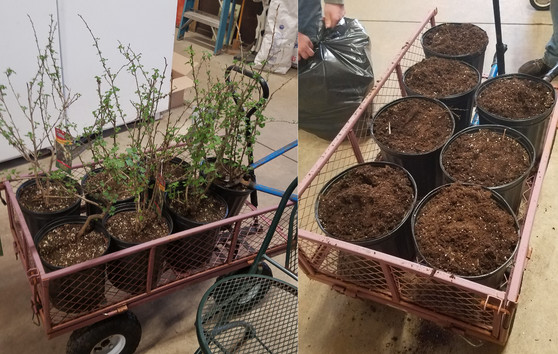 Gooseberry plants before and after destruction
The week before Memorial Day weekend, many states like to remind residents and visitors that emerald ash borer (EAB) is a serious tree-killing invasive insect that spreads easily and undetected in firewood. Hence, Emerald Ash Borer Awareness Week. Now that EAB is in 35 states, having wiped out hundreds of millions of ash trees, the thought of containing it seems like a useless task. Until you think about the fact that there has not been an increase in number of infested states in 3 years. Quarantines and firewood bans have done a lot to slow the spread. Early detection is also an important tool in slowing the spread by helping authorities find new infestations. Here are some ways you can help:
Hang an EAB purple monitoring trap at your business or other properties that may have mature white, green or brown ash present. The trees should be very accessible from a road and in an area where the risk of vandalism is low. The traps will be hung and maintained by DACF staff. If you are interested please contact horticulture@maine.gov.
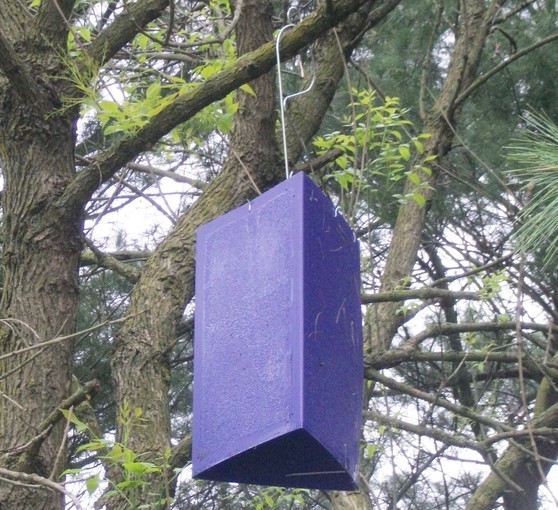 Purple prism trap in an ash tree
Create a trap tree. To create a trap tree, an ash tree is girdled in May or early June. This slowly kills the tree, but it will remain alive through the growing season. Girdling stresses the tree, causing it to release volatile compounds that make it attractive to EAB that may be close by but not detectable. Girdled trees are cut the following fall or early winter and sections are peeled to search for galleries and larvae. Visit the Maine Forest Service’s Trap Tree page for more details.
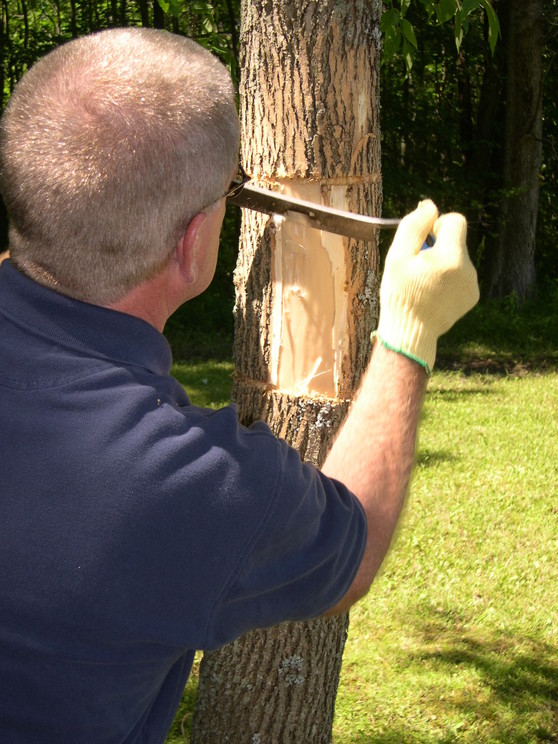 Girdling an ash tree to use as a trap tree
Distribute EAB awareness materials to your customers. We have brochures and rack cards (see below). If you are interested in getting some of these materials, please contact bugwatch@maine.gov.
 Educational materials to distribute to customers
We hope to slow the spread of this deadly insect and you and your employees can be our best allies. Movement of firewood is the highest risk pathway. All you can do to reach out to customers, family and friends to discourage the movement of hardwood firewood more than 10 miles is greatly appreciated.
Find more information about EAB in Maine including maps of the current quarantine areas
Fortunately, other than the gooseberry plants mentioned above, pests observed during spring inspections can be categorized as "the usual suspects" but even these common pests can cause problems if not found early and managed appropriately.
Insects
Aphids are the most common insect pest we've observed in greenhouses so far this year. While most of the finds have been just a few insects, there was one instance where the population was high enough that several pots of large patio peppers were unsellable. Prevent this from happening to you by scouting often and taking action early when aphids are observed. Aphids do not need to mate to reproduce and populations can build quickly.
Thrips were observed on hollyhock, Mandevilla, gerber daisy, annual phlox, eggplant, swiss chard and Argyranthemum, but thus far these populations have been light. You can easily scout for thrips by tapping flowers and foliage on a white sheet of paper and taking note of any insects crawling on the paper.
Spidermite populations have been few and far between, although we have observed some on mandevilla and english ivy. Broadmites were found on blue salvia in one greenhouse. Broadmites are very tiny and even the magnification provided by a good hand lens may not be enough to spot these elusive pests. Looking for plant damage is your best bet of finding an infestation. Be suspicious of curled or thickened leaves and stunting or deformed growing tips and send samples to a diagnostic lab. Broadmites feed on a wide range or plants, but we most often see these damaging New Guinea impatiens and begonias.
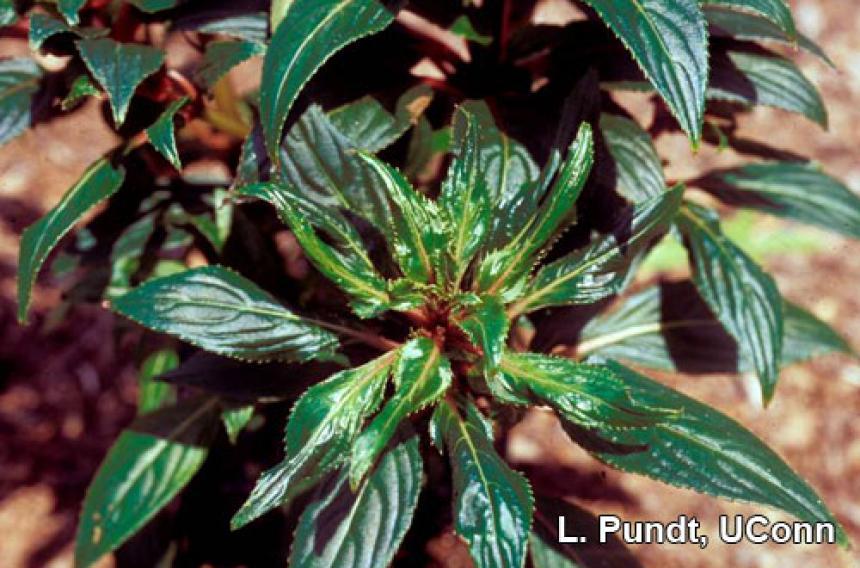 Broad mite damage on New Guinea impatiens
Diseases
So far this spring we have avoided prolonged periods of wet or cloudy weather. This seems to be working in our favor to keep plant disease in the greenhouse to a minimum. There have been a few instances of downy mildew on strawberry and agastache (but not impatiens!), leaf spots on celosia and botrytis on zinnia, coleus, New Guinea impatiens and osteospermum.
Powdery mildew is the most common disease we have observed this spring. Powdery mildew was observed on rose, pear, monarda and strawberry, but was most frequently found affecting rosemary plants. Powdery mildew is a common problem on rosemary, usually seen on larger or older plants, but this spring most of the observations have been from newly planted, younger plants.
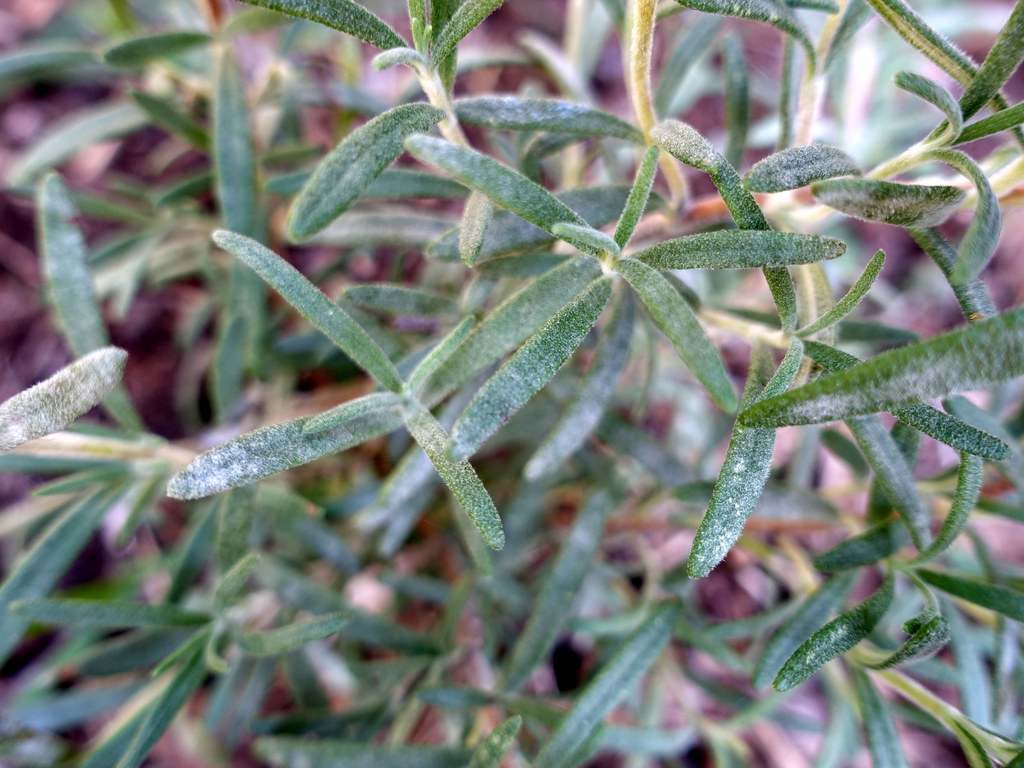 Powdery mildew symptoms on a rosemary plant
|